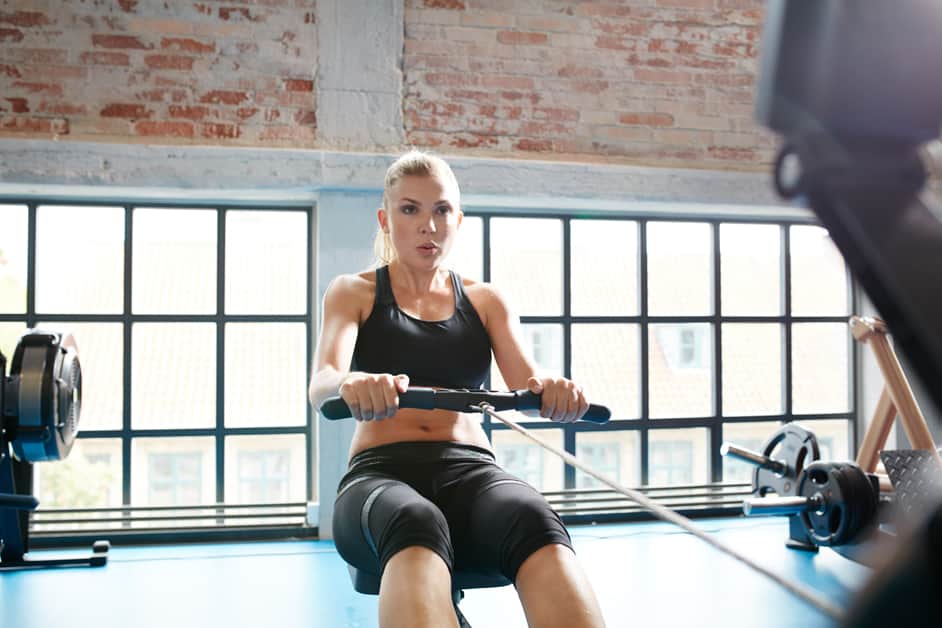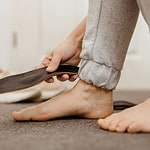Warm Up
Before exercising, warm up! This is key to preventing injuries. People with knee pain should especially focus on warming up. Light stretching, walking, jogging, and foam rolling can help. A good warm-up ensures your tendons, ligaments and muscles are ready for movement. This is vital for reducing the risk of knee injury.
Perform dynamic stretching exercises
Dynamic stretching exercises are a form of exercise that help the body become more flexible. It involves taking a muscle through its range of motion, increasing speed and intensity. Examples include walking lunges, squat-to-stands, arm circles and torso twists.
Medical professionals and research studies suggest doing these to warm up before workouts or any other physical activity. Dynamic stretching has been found better than static stretching when it comes to increasing flexibility before physical exercise. Static stretching doesn’t prepare muscles for exertion like dynamic movements do. That’s why it’s best used after workouts for cooling down with light stretching.
Do a light jog for 5 minutes
Before starting any physical activity, warm up your body with light exercise. A light jog for 5 minutes can get your body ready. This warms up your muscles and prevents injuries by increasing circulation and loosening your joints. It also helps you focus.
When jogging, keep a comfy pace and gradually increase it. Go slow and be aware of how your body feels. If you feel pain or strain, change the intensity or kind of movement. Or stop if needed until speaking to a doctor. After, take a few moments to slow down and stretch tight or uncomfortable areas. Don’t overstretch as this can cause injuries too.
Perform a few sets of bodyweight squats
Do a few sets of bodyweight squats before beginning your workout. Feet should be hip-width apart and toes pointing forward. Slowly lower yourself as if you were taking a seat on an imaginary chair. Don’t go lower than 90 degrees. Push through your heels to stand up. If there’s discomfort, go slow and lower less deeply until strength improves.
Do each rep correctly:
- No strain on the knee!
- Keep chest up.
- Engage glutes instead of quads.
- Don’t let knees collapse inward/outward.
- No bouncing at the bottom.
Preparing muscles and joints this way reduces risk of injuries.
Strength Training
Strength training is critical for exercise. Especially for those with knee pain. It helps with joint stability and builds muscles around the joint. This reduces pain and boosts mobility.
Here, we’ll cover strategies for evening strength training that’s safe for knee pain sufferers:
Choose exercises that are low-impact
Strength training can be beneficial for all ages and fitness levels. Exercises that don’t involve high-impact activities, like running or jumping, can help build strength and endurance without too much strain on the body. Low-impact exercises are more accessible, as they don’t require specialized equipment or higher level of coordination.
These exercises include:
- Planks
- Crunches
- Push ups
- Lateral raises
- Squats
- Leg extensions
- Weight machines
- Pull-up bars
- Pilates/yoga positions
- Tai Chi positions
- Swimming
- Biking
- Walking on an incline
It’s important to focus on proper form before adding intensity or volume to workouts. Listen to your body – stop if anything hurts too much or causes pain. Talk to your doctor before starting any activity program.
Incorporate unilateral movements
Unilateral movements can build strength, working muscles equally on both sides of the body. These exercises challenge balance and stability, which is helpful for controlling muscle strength. Incorporate the following into your training routine:
- Lunges – forward, backward;
- Single-leg squats – static, dynamic;
- Step-ups, box jumps;
- Split squats;
- Single-leg deadlifts;
- Bulgarian split squats;
- Pistol squats.
This type of exercise trains each muscle independently, helping to correct any imbalances. Vary movements to get more overall development, improved stability, and prevent injury. Engaging different stabilizing muscles is key.
Focus on exercises that target the hips and glutes
Hip and glute exercises are essential for improving lower body strength and stability. This can help with balance, reduce injury risk, and keep mobility. Athletes need strong hip muscles for peak performance, so these workouts are great for them.
Common exercises include:
- Squats
- Lunges
- Step-ups
- Hip bridges
- Clamshells
- Lateral walks (with bands)
- Single-leg deadlifts
- Glute kickbacks (with a band or weight machine)
- Donkey kicks
Focus on correct form and breathing when doing these exercises. Start with no weights, then add either reps or weight as you become more comfortable. Doing targeted strength training twice a week will shape the hips and glutes to improve everyday strength.
Cardio
Knee pain? No worries! Low-impact cardio can help. Walking, swimming and biking are great. Here’s how to get the most out of your workout when your knee hurts. Learn the best ways to do cardio with knee pain. Enjoy the results!
Choose low-impact exercises such as swimming and cycling
Low-impact exercises are great for those with knee pain, as they put less strain on the joint. Swimming is a good choice – it’s low-impact and gives an overall body workout. Make sure your stroke technique is correct, to avoid extra pressure on the joint.
Cycling is another good pick – there are usually walking trails or bike paths that let you ride in a comfortable environment. If cycling indoors, use an upright stationary bike instead of a spinning bike – it’ll reduce stress on the joint.
Yoga is ideal for targeting muscles around the joint and increasing strength and flexibility. This can help stabilise the knee and reduce pain. It also stretches tight areas, which can lead to better mobility. Don’t forget to factor in rest days, to let your muscles heal and replenish nitrogen levels.
Use an elliptical machine or a rowing machine
For those suffering from knee pain, working out on an elliptical or rowing machine can be a joint-friendly exercise. Running or jogging are high-impact exercises which can cause pain, but machines like the elliptical or rowing will keep your joints safe.
When using the elliptical, hold the handlebars lightly and keep your back straight to avoid straining your lower back. Adjust the stride length and resistance setting to a moderate level to reduce impact on your joints. The ramp height settings can also be adjusted for less weight on your ankles and knees.
Rowing machines are also good for those with knee pain. Sitting upright with bent legs at 90 degrees supports proper alignment and reduces stress on the joints. When rowing, movements should be controlled with moderated speed and speed down strokes for reduced joint stress.
Avoid running or high-impact exercises
If you experience knee pain and have trouble running or with high-impact activities, it’s best to avoid them. You can still exercise, but switch to joint-friendly activities such as swimming, riding a stationary bike or walking. These are easier on your skin, tendons, muscles and ligaments.
Swimming is a great choice for knee issues. It’s low impact and the water’s buoyancy reduces pressure on joints. Plus, swimming works multiple muscle groups at once for greater calorie burn and muscle tone.
If you’d rather hit the gym at night, use an elliptical machine or stair climber instead of running. This kind of aerobic activity is easier on the knees and still provides excellent cardio benefits. Many YMCAs and health clubs even offer classes for those with knee pain. These focus on low-impact exercises, like cycling with light weights. Strength training is also beneficial. Weight machines can help strengthen leg and core muscles to give extra stability around your joints, while preventing further damage.
Cool Down
Knee pain sufferers who exercise in the evening, take note! Cooling down after a workout is a key part of having a joint-friendly workout. Doing this can reduce swelling, prevent more pain and stiffness, and give the joint time to recover.
What are the best ways to cool down after an evening workout? Let’s discuss!
Perform static stretching exercises
Static stretching is a technique to relax muscles by keeping them in a stretched position for a while. This helps improve flexibility and joint range of motion. To do it, find a comfy spot like the floor or hold onto something like a railing or chair.
- Start with the most painful side and keep your spine and back aligned. Hug your chest and stomach towards your spine. Lower the leg till you feel tightness in your hips. Hold this for 20-30 seconds. Don’t bounce. Do 1-2 reps on each side.
- After this, try dynamic stretching exercises that use gravity. Change poses each time. Don’t go too deep to avoid discomfort.
- Lastly, do upper body endurance training. This will reduce stress on lower extremities like knees.
Use a foam roller to massage your muscles
Massage therapy is an awesome way to relax and recover after a hard workout. Foam rollers are popular for reducing knots, breaking down scar tissue and increasing flexibility. Rolling helps reduce tension, releases tight muscles, improves posture, and increases oxygen flow and circulation.
For maximum benefit, roll your entire body – focusing on major muscle groups like quads, hamstrings, and glutes, as well as smaller areas like the IT band. Here’s a step-by-step:
- Position the roller in the center of where you want to focus. Lower your body onto the roller until it presses into your muscle.
- Roll back and forth on the foam roller several times in each spot. Move up and down, then side-to-side or in circular motions. Apply firm pressure, but not too much.
- Stop rolling when you feel a knot or tension. Hold that spot for 10-15 seconds, then keep rolling. Do this for each major area for about three minutes.
Once finished, stretch out any areas where you worked out knots or tightness. This will help you stay limber for longer duration exercises.
Take a warm bath or shower
Take a long, warm bath or shower in the evening. This can help soothe sore muscles and lessen tension. It can also reduce inflammation and joint pain. A hot bath can help relax your body which eases pressure on muscles and joints from the day’s workout. Hot water opens up your blood vessels, reducing pain.
For extra protection for your joints before and after exercise, try adding mineral salts like Epsom salts to your bath. This will aid in relaxation, allowing for quicker recovery and better protection for future exercise.
Recovery
Recovery is essential for any workout plan – especially for those with knee pain. Remember to give your body time to rest in between days and after a tough session. What you do post-workout can affect your next day’s results.
Here are some suggestions to help you recover after an evening workout and reduce your knee aches:
Get adequate rest
Rest and recovery are crucial for managing knee pain. If you have chronic knee pain, your body needs time to fix joint and muscle damage caused by the day’s activities. The body recovers best when there is no stress. So, take it slow and let your body heal itself.
Incorporate rest periods into your workout routine or follow a doctor’s orders. A full night’s sleep boosts energy levels and reduces CJP, so you can make the most out of your workouts and avoid getting worse. Plus, sticking to a regular sleep schedule releases hormones that help healing, like growth hormone, which helps repair tissue and grow healthy cartilage.
Encourage proper rest requirements to help clients with CJP better stick to their exercise plan. This includes:
- Frequency of activity for best injury prevention outcomes.
- Duration of activity for best injury prevention outcomes.
- Intensity of activity for best injury prevention outcomes.
- Volume of activity for best injury prevention outcomes.
Eat a balanced diet
To prevent knee pain, recovery after an evening workout is vital. Eating a nutritious diet is the key to successful recovery. Include carbs in meals and snacks such as fruits, veggies, whole grains, nuts/seeds, and legumes. This stores energy to use during exercise. Proteins help repair muscle cells while fat aids the body to absorb vitamins and minerals better. Nosh on fatty snacks (like nut butter) after a workout. But, avoid fatty processed foods such as chips or crackers before bedtime, as these can disrupt sleep patterns.
To get the most out of your evening workouts, make sure to get adequate energy from all three macronutrients. This ensures optimal recovery and reduces knee pain from exercising.
Apply ice or heat to the affected area
Ice and heat can help reduce pain from injured joints and muscles. Cold packs make blood vessels smaller, lessening inflammation and calming painful tissue. Heat improves circulation and loosens tight muscles, giving you relief.
To treat joint pain or muscle strain after exercise, use an ice pack for 10-20 minutes, followed by a hot shower or a heat pack for up to 20 minutes. Wrap any cold packs in a towel if putting them on skin, as ice can damage it.
Frequently Asked Questions
Q1: What types of exercises are best for knee pain sufferers?
A1: Low-impact exercises such as swimming, biking, walking, and elliptical training are all good options for knee pain sufferers. Stretching exercises such as yoga and Pilates may also help reduce pain. Additionally, exercises that focus on strengthening the muscles around the knee can help support the joint and reduce pain.
Q2: Is it better to exercise in the morning or evening for knee pain sufferers?
A2: It depends on the individual. Some people who suffer from knee pain may find that it’s easier to exercise in the morning when the joint is still less stiff. Others may prefer to exercise in the evening, when the joint has had time to warm up during the day.
Q3: What other tips should knee pain sufferers keep in mind when working out?
A3: It’s important to always warm up before any physical activity, as this can help reduce joint stiffness. Additionally, it’s important to pace yourself and not overdo it. Listen to your body and stop if you experience any pain or discomfort.





